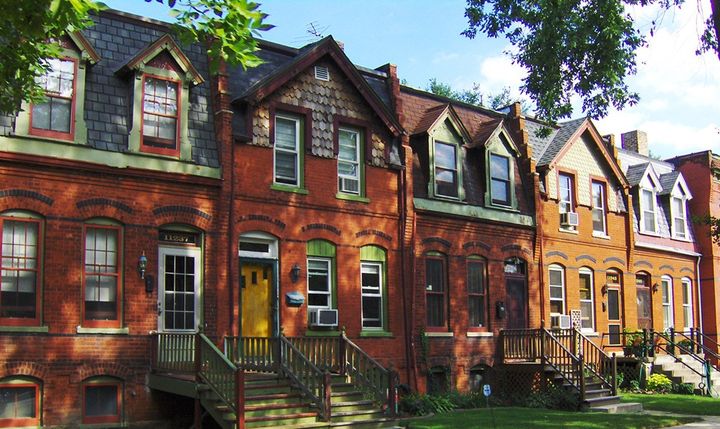
Tenements “A” (left), “B” (center), and “C” (right) located on South Langley Avenue housed some of the lowest paid workers of the Pullman Palace Car Company. A developer plans to bulldoze the remains of Tenement “B” and erect a contemporary apartment building.
In a May 11, 2017 editorial, the Chicago Sun-Times Editorial Board aptly warned that President Trump’s review of federal lands “mustn’t become a giveaway” that privileges the interests of “private speculators” over the interests of the public. The executive order’s explicit intent is to ensure that monument designations don’t “create barriers” to economic growth. Of course, the “barriers” are the very federal laws and regulations that protect these special places from harm.
To make their case against the review, the Editorial Board holds up Chicago’s Pullman National Monument as a shining example of a designation “done in a way that was best for the public” and done not to stifle economic growth “but to spark it.”
The reality is that the 1906 Antiquities Act under which national monuments are established is solely for the purpose of preserving “historic landmarks, historic and prehistoric structures, and other objects of historic or scientific interest“; it says absolutely nothing about encouraging development. And in fact, the history of historic preservation demonstrates that, more often than not, development occurs with little or no regard for preservation.

Historic Pullman Row Houses on South Langley Avenue and located within the Pullman National Monument Boundary.
Presidential Proclamation 9233, established the Pullman National Monument and declared it in “the public interest to preserve and protect the historic objects in the Pullman Historic District.” But now, a real-estate developer stands ready to bulldoze some of Pullman’s ”historic objects” to make way for a 26-unit contemporary infill apartment building it plans to squeeze between two historic buildings it will rehabilitate. The project, the “Pullman Artspace Lofts,” is to be built on a sensitive historic site within the boundaries of both the Pullman National Monument and the Pullman National Historic Landmark District.
Our organization, the Pullman National Monument Preservation Society (PNMPS) and our attorney Thomas J. Ramsdell have warned state and federal agencies that the Pullman Artspace Lofts will destroy the limestone foundation and related archaeological remains of a historically significant Pullman “block house,” Tenement “B,” that survive on the project site. We are advocating for the developer to reconstruct Tenement “B” upon its original foundation to preserve Pullman’s original plan and to restore this unified tenement “block house” complex.
The impression has been given to the public at large that Pullman’s national monument designation is going to protect the “historic objects” of the Town of Pullman located within the 203 acres circumscribed by the “National Monument Boundary.” In reality, the National Park Service purports it only has authority over a postage stamp-sized parcel of land it owns (.2397 acres) and upon which sits Pullman’s reconstructed clock tower. As if to bolster this assertion, it hasn’t so much as lifted a finger to protect the remains of Tenement “B.”
Consequently, as concerned citizens and residents of the monument, we have been left to expend thousands of dollars and countless hours to ensure that this ONE development project is completed lawfully. Evidence suggests to us this has not been the case. At present, the Advisory Council on Historic Preservation is investigating our allegations that state officials worked with the developer to hide its application for federal financing. This was done, in our opinion, to defer or avoid entirely the historic review of the project required by Section 106 of the 1966 National Historic Preservation Act. By delaying or evading such a review, the developer can avoid public oversight and ignore possible alternatives that may better protect Pullman’s coherent design and historic authenticity.
We agree. President Trump’s executive order is troubling: truly important monuments established to preserve our heritage could be whittled away at the behest of private interests, and the Antiquities Act itself could potentially be threatened. But, really, is this so different than creating national monument designations that are more symbol than substance?
